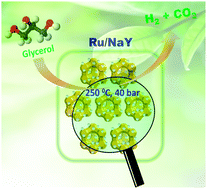Insights into the catalytic activity of Ru/NaY catalysts for efficient H2 production through aqueous phase reforming†
Abstract
Ruthenium nanoparticles supported on NaY zeolite catalysts were synthesized by a simple ion exchange method. The structural and morphological features of the catalysts were systematically investigated using numerous techniques such as N2-sorption, XRD, CO2-TPD, H2-TPR, TEM, SEM, ICP-OES, TGA, CHN analysis, XPS, in situ CO-FTIR and NMR spectroscopy. These novel Ru–NaY catalysts were highly active and selective for H2 production through aqueous phase reforming (APR) of glycerol and ethylene glycol. Among the various catalysts evaluated for H2 production, the 3 wt% Ru–NaY catalyst demonstrated the highest catalytic performance with excellent H2 selectivity and this catalyst exhibits better activity as compared to many state of the art catalysts reported so far. The superior catalytic activity of 3 wt% Ru–NaY was attributed to the appropriate Ru metal loading, good metal dispersion, small size of Ru nanoparticles, better metal-support interaction, and higher availability of catalytically active sites (Ru0) and facilitated water gas shift (WGS) reaction. This catalytic activity result clearly shows that NaY zeolite supported Ru nanoparticles catalysts have excellent potential for H2 production from biomass-derived compounds.



 Please wait while we load your content...
Please wait while we load your content...